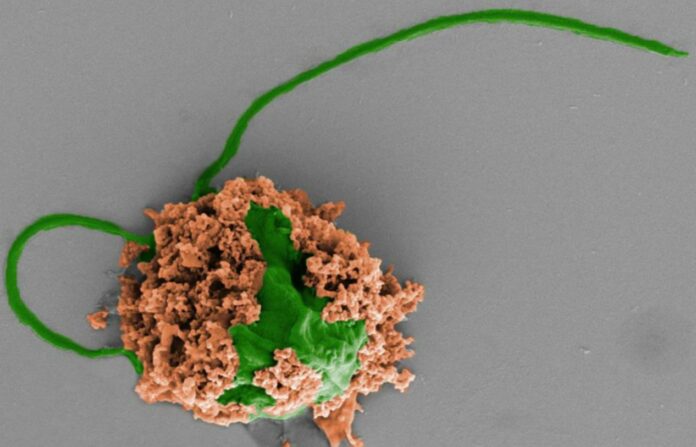Microrobots, created by nanoengineers at the University of California, San Diego, can carry medication, swim around in the lungs, and be used to treat life-threatening cases of acute bacterial pneumonia.
In mice, these tiny robots safely got rid of bacteria in the lungs that caused pneumonia, and all of the mice lived. Infected mice that were not treated, on the other hand, all died within three days.
The study’s findings were published in the journal Nature Materials today.
The algae cells used to create the microrobots had antibiotic-filled nanoparticles all over their surfaces. The algae give the microrobots movement, which lets them swim around and directly deliver antibiotics to more bacteria in the lungs.
Antibiotic-containing nanoparticles are composed of microscopic biodegradable polymer spheres covered with the cell membranes of neutrophils, a kind of white blood cell. What makes these cell membranes special is that they absorb and neutralise inflammatory molecules made by bacteria and the immune system of the body. This means that the microrobots can reduce harmful inflammation, which makes them better at fighting lung infections.
Both Joseph Wang and Liangfang Zhang, professors of nanoengineering at the UC San Diego Jacobs School of Engineering, collaborated on the project. Wang is a global expert in the study of micro- and nanorobotics, and Zhang is a global expert in the creation of nanoparticles that resemble living cells to treat illnesses and infections.
Together, they have paved the way for the creation of miniature drug-delivery robots that can be used to safely treat bacterial infections in the blood and stomach of living animals. The most recent aspect of their work involves treating bacterial lung infections.
“Our goal is to do targeted drug delivery into more challenging parts of the body, like the lungs. And we want to do it in a way that is safe, easy, biocompatible and long lasting,” says Zhang. “That is what we’ve demonstrated in this work.”
The scientists treated mice with Pseudomonas aeruginosa-caused acute pneumonia using microrobots to prevent death in some cases. This type of pneumonia usually affects patients in the intensive care unit who are on mechanical ventilation. Through a catheter placed in the mice’s windpipe, the researchers delivered the microrobots to their lungs. After one week, the infections were entirely under control. Mice not given the microrobot treatment died after three days, while every mouse treated with them lived for more than 30 days.
The microrobot treatment was also more successful than an IV injection of antibiotics into the circulation. In order to accomplish the same impact, the latter needed an antibiotic dose that was 3000 times larger than what was employed in the microrobots. For instance, an IV injection delivered 1.644 milligrammes of antibiotics per mouse, while a dose of microrobots delivered 500 nanograms.
The team’s strategy is particularly effective because it delivers the medication directly to the site of action rather than dispersing it throughout the body.
These findings demonstrate how active mobility from the microalgae and focused medication delivery might enhance therapeutic effectiveness, according to Wang.
“With an IV injection, sometimes only a very small fraction of antibiotics will get into the lungs. That’s why many current antibiotic treatments for pneumonia don’t work as well as needed, leading to very high mortality rates in the sickest patients,” explains co-author Victor Nizet. “Based on these mouse data, we see that the microrobots could potentially improve antibiotic penetration to kill bacterial pathogens and save more patients’ lives.”
“And if the thought of putting algae cells in your lungs makes you squeamish, the researchers say that this approach is safe. After treatment, the body’s immune cells efficiently digest the algae, along with any remaining nanoparticles. “Nothing toxic is left behind,” adds Wang.
The project is still in the proof-of-concept phase. To precisely understand how the microrobots interact with the immune system, the team plans to conduct a further deeper investigation. Prior to testing it on larger animals and eventually on humans, the microrobot treatment will also undergo studies to validate it and be scaled up.
“We’re pushing the boundary further in the field of targeted drug delivery,” adds Zhang.
Source: 10.1038/s41563-022-01360-9
Image Credit: FANGYU ZHANG AND ZHENGXING LI
You were reading: Lung Infection: A Microscopic Robot To Treat Deadly Pneumonia
